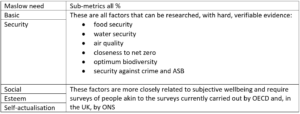Wouldn’t it be great if there was a single, science-based metric that described “placemaking”? And wouldn’t it also be great if the same metric could describe a place that has “levelled up”? As well as allowing landlords to chart their progress on this agenda, it would also provide great details for ESG reports. The “E” part of ESG reporting is relatively well understood and good environmental consultancies can generate excellent performance reports for social landlords. But what about the “S” part? This is notoriously difficult, and yet shouldn’t it be key to how a great “place” is described? Meaningful metrics are certainly sought after by the investment community.
This article is a call for a science based “placemaking metric” and describes such a metric. Following the adage that you can only “manage what you measure” the ideal would be a single kpi that organisations can monitor at a strategic level.
A good start is the premise that 100% of all of us on the planet want 100% happiness for ourselves and for our loved ones. This means that a placemaking metric can be a % figure. Here are some features that such a metric should consider and why:

Most of those features are pretty self-explanatory, but it may be worth exploring the idea of surveying residents’ wellbeing as this may be a new one! Whenever people speak about measuring wellbeing, one of the first issues they raise is that they believe wellbeing is subjective and that everyone has a different idea of what it means. In fact, there is an emerging science of measuring wellbeing. The most common way that positive psychologists do this is by measuring what’s called subjective wellbeing. Typically, this takes the form of asking someone how they would rate their life satisfaction, where 10 is very satisfied and 0 is very unsatisfied. There is still a degree of fuzziness about this approach, such as who is in a position to argue whether someone is actually a 7 out of 10 and not an 8 out of 10. Nevertheless, there is a degree of biological truth to this. If someone marks themselves 8 out of 10 then, in general, their friends will also see them as an 8-out-of-10-type person. In addition, high subjective wellbeing scores do correlate with higher levels of so-called happiness hormones in our bodies. As an aside, these hormones are Oxytocin, Dopamine, Endorphins and Seratonin, which, by happy coincidence, can be memorised as ‘ODES to joy’.
Internationally, OECD countries have committed to measuring these types of statistics since 2007; and, in the UK, the Office for National Statistics publishes them regularly. What’s more, the idea is creeping into Treasury’s Green Book, which has methodologies for assessing policy impacts. Sadly, the UK methodology still wants policy advisers to translate the wellbeing statistics into pounds and pence, even though none of this money is real. Perhaps that will change in the future.
Perhaps a great way to look at the problem is using a framework developed by 1950s psychologist Abraham Maslow. His theory, which has been substantiated by later research, is that, as humans, we all have five needs, regardless of race, nationality, age, ability, gender etc. How we satisfy those needs may be very different for different people, but we are trying to satisfy those same needs. Here’s how an overall metric would look through a Maslow prism:

Weighting will need to be researched to allow the combination of all these sub-metrics into a single over-arching figure called ‘long-term wellbeing’. But, as a start, some mini-research indicates that around 75% of our total wellbeing is derived from basic and security needs, and 25% from the remaining needs.
A benefit of this approach is that it can identity “gaps” in residents’ wellbeing. For example if there are consistently low scores for “loneliness” or “satisfaction with social life” then perhaps there is a need for a social centre. Or the landlord could do some signposting for residents to join existing groups.
This framework satisfies all the conditions mentioned earlier, especially the one about describing what ‘good’ looks like. In other words, if 100% of all those needs are met for 100% of all the people on the planet, then we as a human race have achieved 100% happiness.
Richard Lupo MIEMA, CEnv is managing director of SHIFT Environment, and author of Happiness by Numbers which explore the topics in this article. More details on the book and the launch event on 27th April can be found here: https://shiftenvironment.co.uk/news/happiness-by-numbers-how-to-measure-and-manage-your-wellbeing-to-make-a-positive-impact-on-the-world/


